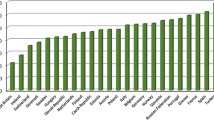Abstract
The stratification system in India has resulted in the socioeconomic inequality in society and defines women domestic workers as one of the lowest segments of society. This qualitative and quantitative study aims at describing the problems of female domestic workers, the relationship of their employers with them, and exploring the impact of socioeconomic status mainly, occupation, education, and income on life satisfaction. We used ethnographic observation and in-depth interview over a 4 year period in Mysore (a city in the south of India). Furthermore, our quantitative research was guided by convenience sampling technique with selecting 125 (65 domestic workers, 60 employers). We prepared a structured questionnaire for gathering demographic information, i.e. age, education, marital status, occupation, and religion. To measure the degree of life satisfaction, we administered Satisfaction with Life Scale (Diener et al. J Person Assess 49(1):71–75, 1985). The data were collected during September and October 2011. The hypotheses were tested by applying Pearson correlation, regression, and t test (SPSS, version 18). The results of our observation and interview indicate that domestic workers suffer from various problems inside and outside their homes. The relationship between domestic workers and employers is a master–servant relationship. Domestic workers remain as an unorganized job group though in 2004 the Karnataka Minimum Wage Act was passed. Our quantitative findings reveal that there is a positive correlation between socioeconomic status and life satisfaction. This type of study displays that enacting law is not sufficient; it necessitates implementing and monitoring properly. This study suggests measures for supporting female domestic workers.
Similar content being viewed by others
Notes
The National Domestic Workers Movement is a NGO working and campaigning for domestic workers, child domestic workers, and migrant workers. http://ndwm.org/.
Is a state in the south of India, Mysore is one of its cities.
References
Alesina, A., & La Ferrara, E. (2005). Ethnic diversity and economic performance. Journal of Economic Literature, XLII, 762–800.
Bourdieu, P. (1973). Cultural reproduction and social reproduction. In R. Browen (Ed.), Papers in the sociology of education (pp. 71–112). London: Tavistech.
Clark-Lewis, E. (1994). Living in, living out: African American domestic in Washington DC 1910–1940. Washington: Smithsonian Institution Press.
Coleman, J. (1987). Families and schools. Educational Researcher, 16(6), 32–38.
Deshpande, A. (2001). Caste at birth? Redefining disparity in India. Review of Development Economics, 5(1), 130–144.
Diener, E. (1984). Subjective well-being. Psychological Bulletin, 95(3), 542–572.
Diener, E., Emmons, R., Larsen, R., & Griffin, S. (1985). Satisfaction with life. Journal of Personality Assessment, 49(1), 71–75.
Ehrenreich, B. (2001). Nickel and Dimed. America: Metropolitan/Owl Book.
Gururaj, G., Benegal, V., & Girish, N. (2004, February). Psycho social impact of alcohol: The hidden public health burden. In The national conference of IAPSM, Chandigarh.
Harrison, L., & Gardiner, E. (1999). Do the rich really die young? Alcohol related mortality and social class in Great Britain 1988–94. Addiction, 94(12), 1871–1880.
Herman, A. (1991). A brief introduction to Hinduism: Religion, philosophy, and way of liberation. Boulder, CO: Westview.
Jha, R. (2004). Reducing poverty and inequality in India: Has the liberalization helped? In G. Cornia (Ed.), Inequality growth and poverty in an era of liberalization and globalization (pp. 297–327). New York: Oxford University Press.
Johdka, S. (2002). Community and identities: Contemporary discourses on culture and politics in India. Thousand Oaks, CA: Sage.
Khallad, J. (2000). Education and carrier aspirations of Palestinian and U.S. youth. Journal of Social Psychology, 140, 789–792.
Lal, D. (1989). The Hindu equilibrium: Cultural stability and economic stagnation. Oxford: Clarendon Press.
Markewitz, S. (2000). The price of alcohol, wife abuse husband abuse. Southern Economic Journal, 67(2), 279–303.
Miranda, S. P. (2007). Exploring themes in the scholarship on twentieth century domestic work in Canada and the United State (pp. 113–129). York University.
Parsons, T. (2005). The social system. UK: Taylor & Francis.
Raka, R. (2000). Masculinity, feminity and servitude: Domestic workers in Calcutta in the late Twentieth century. Feminist Studies, 26(3), 691–718.
Reynolds, J. R., & Ross, C. E. (1998). Social stratification and health: Education’s benefit beyond economic and social origins. Social Problems, 45(2), 221–247.
Siddhatha, S. (2005). Women as paid domestic workers. Journal of Social Science, 11(1), 35–41.
Singh, N., Bhandari, L., Chen, A., & Khare, A. (2003). Reginal inequality in India: A fresh look. Economical and Political Weekly, 38(11), 1069–1073.
Trusty, J. (2002). African, American’s educational expectations: Longitudinal causal models for women and men. Journal of Counseling and Development, 80(3), 332–345.
Vijayendra, R., & Radu, B. (2007). The political construction of caste in south India. The word Bank.
Watson, C. M., Quatman, T., & Edler, E. (2002). Career aspirations of adolescent girl: Effects of achievement level, grade, and single school environment. Sex Roles, 46, 323–335.
Weber, M. (1995). On class. In P. Joyce (Ed.), Class (pp. 31–40). New York: Oxford Press.
Wilkinson, R. G. (1996). Unhealthy societies: The afflictions of inequality. London: Routledge.
Wilkinson, R. G. (1997). Health inequalities: Relative or absolute material standard. The British Medical Journal, 314, 591–595.
Author information
Authors and Affiliations
Corresponding author
Rights and permissions
About this article
Cite this article
Daraei, M., Mohajery, A. The Impact of Socioeconomic Status on Life Satisfaction. Soc Indic Res 112, 69–81 (2013). https://doi.org/10.1007/s11205-012-0040-x
Accepted:
Published:
Issue Date:
DOI: https://doi.org/10.1007/s11205-012-0040-x




